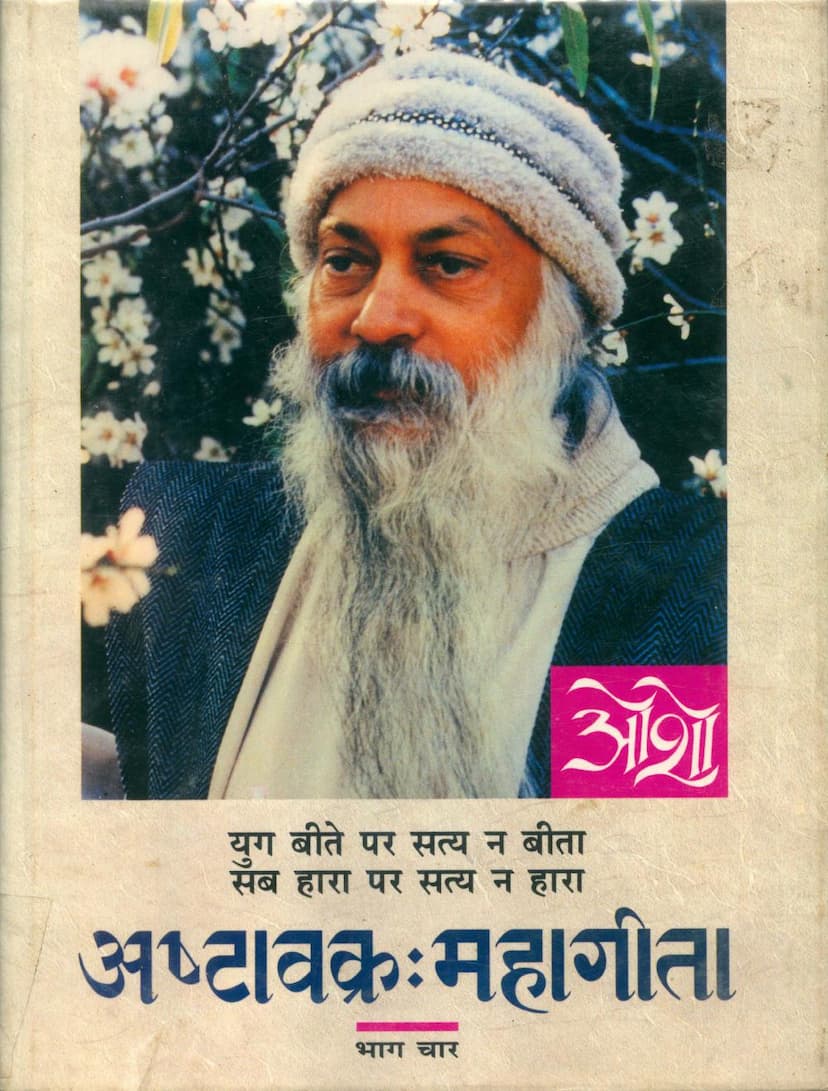Ashtavakra Mahagita Part 04
Added to library: September 1, 2025

Summary
The provided text is the fourth part of the "Ashtavakra Mahagita" by Osho Rajnish, published by Rebel Publishing House. This summary focuses on the content of the provided pages (1-439), which primarily consist of discourses by Osho on verses 152-196 of the Ashtavakra Gita. The book is a compilation of fifteen discourses given from November 26 to December 10, 1976, in Pune, India.
Here's a summary of the key themes and ideas presented in the provided text:
Core Teachings and Concepts:
- Transcendence of Desire and Attachment: Osho emphasizes the need to let go of all desires, not just worldly ones, but also the desire for liberation (moksha) itself. True freedom comes from being desire-less. He suggests that attachment to anything, including spiritual goals, acts like an umbrella preventing one from experiencing the bliss that is already present.
- The Nature of Reality and the Self: The text delves into the nature of the Self, distinguishing it from the body and the mind. Osho explains that the mind is an illusion, a "bhranti" (illusion) arising from identification. The true Self is beyond these constructs.
- "Ras" (Essence/Bliss) as the Ultimate Goal: Osho clarifies that "ras" is not just a stage but the ultimate destination. It is the divine essence, the state of being "raso vai sah" (He is indeed bliss). To be absorbed in this bliss is the supreme state, where neither the self nor the other remains; only oneness exists.
- The Self as the Source and Destination: The ultimate achievement is to realize that one is already complete, already the source, and already the destination. The journey is simply the recognition of this inherent truth.
- The Importance of Witnessing (Sakshi): Osho repeatedly stresses the practice of "sakshi" (witnessing). He explains that witnessing is not about changing the self but about observing without judgment. This act of pure observation is the path to transformation.
- Beyond Duality: The teachings highlight the need to move beyond dualities like good and bad, pleasure and pain, gain and loss, self and other. The awakened individual, the "jivanmukta" (liberated while living), transcends these dualities.
- The Nature of the Enlightened Being: An enlightened being, a "jivanmukta," is described as one who is no longer bound by desires or attachments, who lives spontaneously, detached yet compassionate. They are like a lotus, untouched by the mud of the world. Osho uses the example of Masters like Buddha, Mahavir, Krishna, Jesus, and Muhammad to illustrate how they embodied this transcendence.
- Osho's Role as a Catalyst: Osho positions himself as a mirror reflecting the wisdom of Ashtavakra. He is not presenting his own philosophy but reinterpreting ancient teachings for the contemporary mind, making them relevant through his unique "anupayogik darshan" (applied philosophy). He integrates insights from various spiritual traditions, including Taoism, Zen, and Sufism.
- The Path of Love and the Path of Meditation: While Osho acknowledges both the path of love (surrendering the self into the All) and the path of meditation (absorbing the All into the self), he emphasizes that both lead to the same non-dual state.
- Critique of Conventional Spirituality: Osho challenges traditional notions of spirituality that involve rigid practices, renunciation, or striving for a distant goal. He advocates for a spontaneous, natural, and joyful approach to awakening.
- The Body as a Temple: The body is not to be despised but recognized as the very temple of the divine. Reverence for the body and its natural functions is crucial.
- The Illusion of "Doing": True spiritual growth comes not from "doing" but from "being." The effort to achieve something, even spiritual achievement, becomes an obstacle. The key is to let go of effort and allow what is to unfold.
- The Meaning of "Tathata" (Suchness): Osho connects Ashtavakra's teachings with Taoist "Tathata" and his own concept of "suchness." This means accepting reality as it is, without resistance or judgment.
- The "Alsi Shiromani" (Chief of the Lazy): This concept refers to the enlightened one who has transcended all effort and striving. They are effortlessly present, like a perfectly balanced instrument, responding to existence without the interference of the ego.
- The Nature of Desire and Suffering: Desire (trishna) is identified as the root of suffering. The path to freedom lies in understanding and dissolving this desire, not in fulfilling it or suppressing it.
- The Importance of Inner Observation: The discourses stress the importance of introspection and self-observation to understand one's own conditioning and the mechanisms of the mind.
Key Figures and Concepts Mentioned:
- Ashtavakra: The central figure in the Ashtavakra Gita, a sage who imparts profound wisdom.
- Janak: The king and disciple to whom Ashtavakra imparts the teachings.
- Osho: The commentator and interpreter of the text, presenting these ancient teachings in a modern context.
- "Ras" (Essence/Bliss): The ultimate state of being, the divine essence.
- Sakshi (Witness): The state of pure, non-judgmental awareness.
- Tathata (Suchness): Accepting reality as it is, without resistance.
- Tao: The fundamental principle or law of the universe in Taoism.
- "Amal" (Innocence/Childlike State): A state of being free from conditioning and ego.
- "Nishkam" (Desireless): One who is free from all desires.
- "Galitdhih": One whose intellect has dissolved, indicating a state beyond conceptual thinking.
Overall Message:
The "Ashtavakra Mahagita Part 04" as presented through Osho's discourses is a profound exploration of spiritual liberation. It emphasizes that true freedom is not an external acquisition but an inner realization of one's inherent, already-existent divine nature. By understanding the nature of the self, transcending desire and ego, and embracing a state of pure witnessing and acceptance, one can realize the ultimate bliss that is ever-present. The teachings encourage a direct, experiential path rather than intellectual adherence to doctrines or practices.